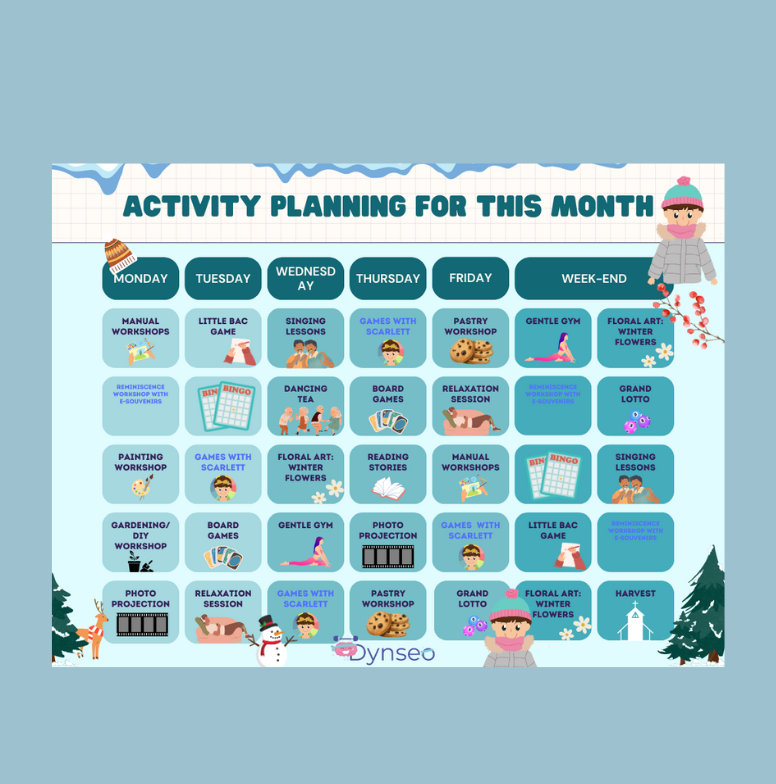Nursing homes, care homes, skilled nursing facilities, ) are essential for providing residents with a pleasant and stimulating living environment. Setting up a well-structured activity schedule is a crucial step in ensuring their well-being. In this article, we’ll explore the key steps to creating an activity schedule in nursing home that meets residents’ needs and enhances their quality of life.
Why is it important to establish an activity program for nursing homes?
An activity schedule is not just a set of tasks to be accomplished, but a means of ensuring residents’ physical, mental and emotional well-being. Here’s why it’s so important:
- Cognitive stimulation: Varied, engaging activities stimulate residents’ cognition, strengthening their mental functions.
- Socialization: Group activities promote socialization, reduce isolation and improve the quality of relationships.
- Quality of life: Recreational and creative activities bring joy, fulfillment and satisfaction to residents.
- Preventing health problems: Physical activity helps prevent health problems associated with immobility.
Activity planning in EHPAD offers the following advantages:
-
Clear structuring: A pre-established schedule provides a well-defined organization of residents’ days, creating a routine that is beneficial to their well-being.
-
Reduced anxiety: By anticipating upcoming activities, residents experience less anxiety, fostering a reassuring environment.
-
Diversification of activities: A well-designed schedule enables us to offer a variety of activities, thus responding to residents’ varied interests and preventing boredom.
-
Optimization of staff time: By facilitating planning, staff can focus on interaction and individualized support, improving residents’ quality of life.
-
Day-to-day efficiency: Using a ready-to-use schedule contributes to more efficient day-to-day management of the facility, benefiting both residents and staff.
Steps for creating an activity schedule for nursing homes
Creating an activity schedule in nursing homes is an essential step in creating a rich and fulfilling environment for residents. By getting to know residents, diversifying activities, and involving residents in the process, gerontology animators can create schedules that improve residents’ quality of life and promote their well-being. The result is a senior living facility where residents can flourish and enjoy their lives to the full. Creating an effective nursing home activity schedule requires a structured, well-thought-out approach. Here are the essential steps to follow:
1. Know your residents
Before designing a schedule, it’s crucial to understand each resident’s interests, preferences and needs. Take into account mobility levels, health problems and personal preferences.
2. Diversify activities
Good planning includes a variety of activities to ensure there’s something for everyone. This can include art, music, sports, cooking, gardening, reading, memory and much more.
3. Plan ahead
Set up a weekly or monthly activity schedule. Plan a balance between regular activities and special events.
4. Equip yourself with the necessary resources
Make sure you have all the equipment and space you need for each activity. Prepare supplies in advance to avoid unnecessary interruptions.
5. Involving residents
Involving residents in the planning and execution of activities is paramount for fostering a vibrant and inclusive community. By actively engaging residents in these processes, it not only enriches their overall experience but also strengthens their sense of belonging and autonomy.
- When residents are encouraged to participate in the planning phase of activities, it provides them with a sense of ownership and investment in the events. They feel valued and respected, knowing that their preferences and opinions are being considered. This involvement can range from simple decision-making tasks such as choosing the theme for an upcoming event or suggesting activities they would like to see implemented, to more hands-on involvement in organizing logistics or leading specific aspects of an activity.
- Involving residents in carrying out activities empowers them to take an active role in shaping their daily experiences. Whether it’s assisting in setting up decorations for a party, leading a discussion group, or even showcasing their talents during a talent show, residents are given opportunities to contribute in meaningful ways. This not only enhances their self-esteem and confidence but also fosters a sense of purpose and accomplishment.
- Active involvement in activities can help combat feelings of isolation or loneliness that some residents may experience. By participating in shared experiences and forming connections with fellow residents and staff members, individuals can cultivate a sense of community and camaraderie. This social engagement is essential for promoting overall well-being and mental health among residents.
So, encouraging and facilitating the involvement of residents in the planning and execution of activities within nursing homes is a fundamental aspect of providing person-centered care. By recognizing and honoring the preferences, abilities, and contributions of residents, nursing homes can create a more inclusive and fulfilling environment where residents feel valued, connected, and empowered.
6. Evaluate and adjust
Regularly evaluating the effectiveness of the activity schedule is essential for ensuring that it meets the evolving needs and preferences of both residents and staff. By actively soliciting feedback from residents and staff members, nursing homes can gain valuable insights into which activities are most engaging, enjoyable, and beneficial. This feedback loop allows for adjustments to be made promptly, ensuring that the schedule remains dynamic and responsive to the changing dynamics of the community.
Plus, being receptive to feedback demonstrates a commitment to resident-centered care, where the voices and experiences of those living and working within the facility are valued and prioritized. This ongoing evaluation process fosters a collaborative environment where everyone plays a role in shaping the activities and experiences within the nursing home, contributing to a more vibrant and fulfilling community overall.
Easy-to-integrate activities in nursing homes
Planning activities in nursing homes requires a variety of activities adapted to meet the needs of residents. Here are a few examples of easy-to-integrate activities that can enrich residents’ daily lives:
Scarlett Games ready to go
Scarlett games are designed to stimulate nursing homes residents in a holistic way. They promote exchange between residents and staff, create a relaxing atmosphere, encourage social interaction, offer therapeutic opportunities and enable the sharing of stories and past experiences. Scarlett games include activities such as crosswords, quizzes, group discussions and memory games.

Lotto and Bingo
Lotto and bingo are popular activities in nursing homes, as they are easy to organize and bring pleasure to residents. These games enhance concentration, coordination and communication. They are often accompanied by small prizes to add an element of friendly competition.
Gentle gymnastics with a foam ball
Foam ball exercises are an excellent way of improving motor skills and coordination, whatever the resident’s level of mobility. Activities such as softball throwing, juggling or wheelchair ball games can be easily integrated into the activity schedule.
Musical activities
Music is a powerful means of stimulating emotions and memory. Sessions of singing, dancing, or even simply listening to music are activities that can be adapted to different levels of physical and cognitive ability. Residents can also take part in creative music workshops, such as percussion playing.
These easy-to-integrate activities are designed to offer a range of options for senior living residents. By encouraging participation and adapting activities to meet individual needs, gerontology coordinators can create a stimulating and friendly environment that contributes to residents’ quality of life.
Examples of Activity Planning in nursing homes
To help you get started, we’ve put together some free sample activity plans for nursing homes. These planning templates are designed to offer a variety of activities tailored to residents’ needs, and can be used as a basis for creating your own personalized plan. Download these examples to simplify your activity planning and provide a rich, stimulating experience for the residents of your nursing home.

As an activity coordinator in a nursing home, my time is precious. I work part-time, which means that every minute counts to give residents the best possible experience. Activity planning is one of the most important tasks in my job, but it can quickly become a source of stress if you don’t have the right tools.
This is where the activity program I’ve started to use comes in. Not only did this software save me time, it also simplified the planning process considerably. I now have access to a complete library of activity ideas adapted to different levels of mobility and interest.
What’s particularly valuable to me is the flexibility of this program. I can quickly tailor the schedule to the individual needs and preferences of the residents. What’s more, the software allows me to track activities already organized and evaluate their success, which helps me to continually improve our offering.
Thanks to this program, I can spend more time interacting with the residents, getting to know them and responding to their specific needs. My work has become more efficient and satisfying, and I’m convinced that this has had a positive impact on the quality of life of our residents.
If, like me, you’re a part-time activity director looking for a way to maximize your time and offer quality activities, I highly recommend exploring the benefits of an activity program. It can really make a difference, making your daily life easier and improving the lives of our seniors.
Other articles that might interest you:
The Role of Cognitive Apps in Speech Therapy for Alzheimer’s Patients
Alzheimer’s disease is a progressive neurological disorder that primarily affects memory, thinking, and behavior. As...
Memory Apps for Alzheimer’s: Enhancing Recall in Speech Therapy Sessions
Alzheimer's disease is a progressive neurological disorder that primarily affects memory, thinking, and behavior. As...
Cognitive Rehabilitation Apps for Speech Therapy with Alzheimer’s Patients
In recent years, the landscape of cognitive rehabilitation has evolved significantly, largely due to the advent of...







